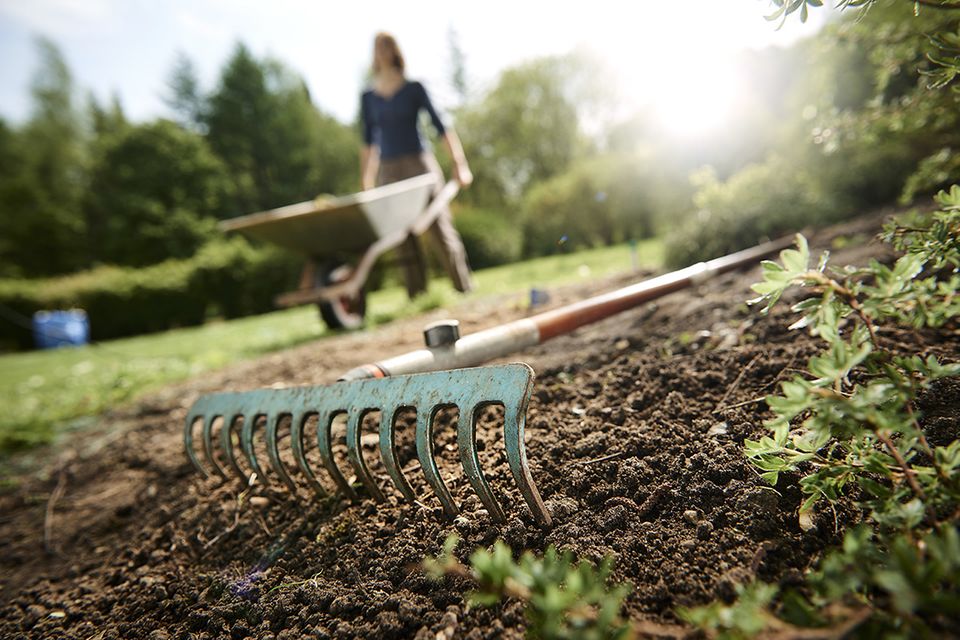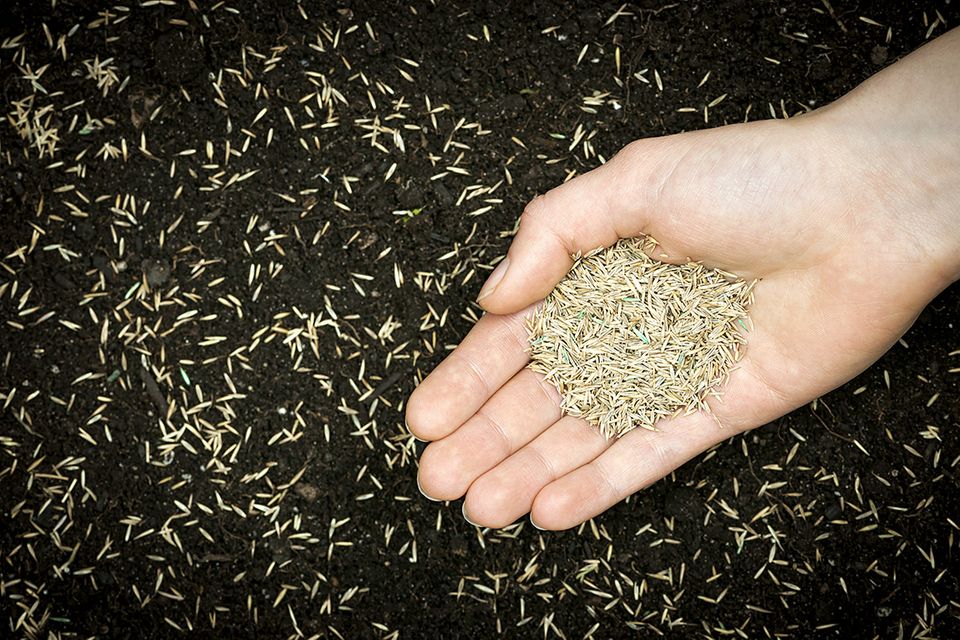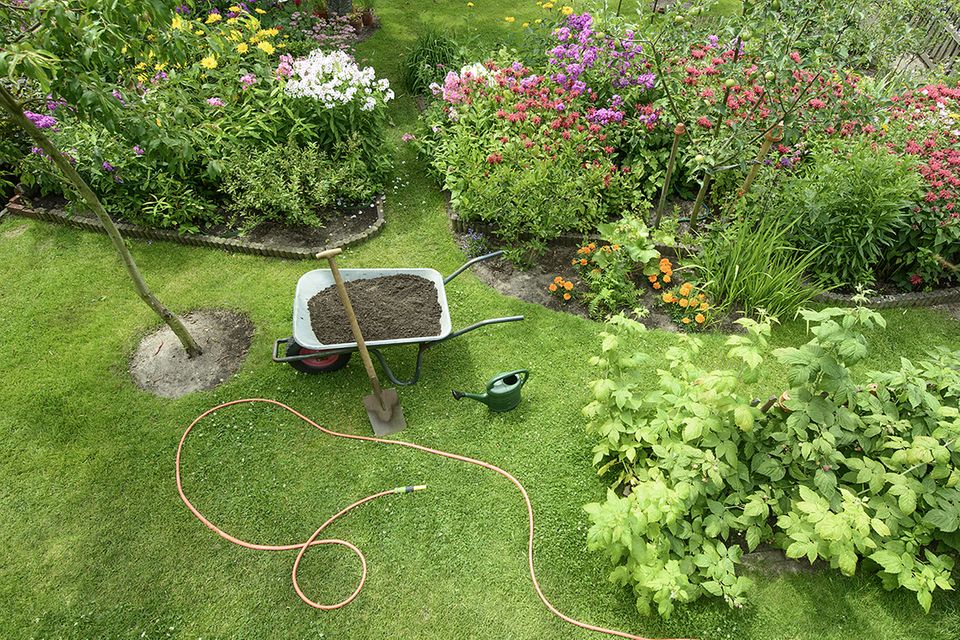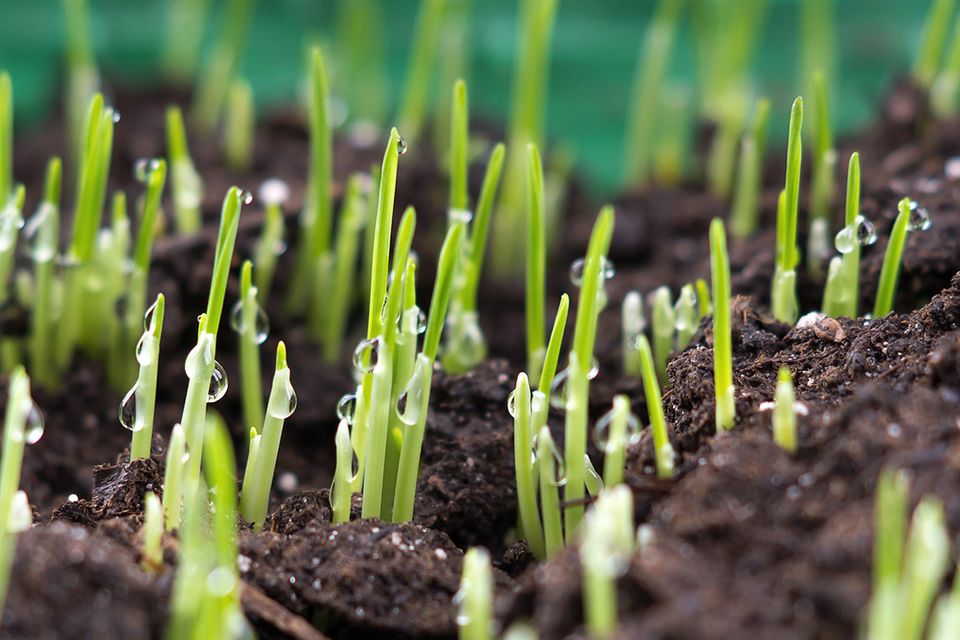You want to sow lawn, but do not know how? Do not worry, with our tips you will soon have a green carpet in the garden, robust enough even for playing children and garden parties.
Sowing lawn – what sounds so easy at first, in practice has some crucial points that need to be considered. Because not all lawn mixtures are the same, the season plays a decisive role in success and the position of the sun in the garden also plays an important role. But first things first.
Contents
- 1 Prepare the ground to sow lawn
- 2 Which lawn would you like?
- 3 How much lawn per square meter?
- 4 From when to sow the lawn?
- 5 Water well and sustainably
- 6 When can you mow the lawn for the first time?
- 7 When should you fertilize the lawn?
- 8 Is it possible to sow lawn in autumn?
- 9 Combine lawn with other plants
- 10 Author
Prepare the ground to sow lawn
If you want to replant your lawn, it requires some work beforehand, as with sod. If there are still remnants of the Altrasens, it must be carefully removed. The ideal tool for this is a power hoe, which you can often borrow from a hardware store. It lifts the old sod underneath and loosens the soil several centimeters in depth. It is also recommended for areas on new buildings, as heavy construction vehicles often have heavily compacted the soil in the future garden. Alternatively, you can use a spade and muscle power to remove the old turf and loosen the soil. However, this requires a decent amount of strength.
After digging the soil should be leveled and further prepared for sowing the lawn.
Use a garden rake to rake the soil nice and smooth.
Any stones, branches and other larger elements such as root debris should be collected right away.
Make sure that there are no unnecessary depressions or unevenness.
Then consolidate the ground again with a lawn roller – you can also borrow one from a DIY store. Alternatively, you can let the soil rest for two weeks, and it will settle on its own.
After leveling or the two-week rest period, the top layer should now be lightly roughened with a rake by a few centimeters so that the soil lies loosely.
Now the soil is perfectly prepared for replanting the lawn. You only need to choose the right seed.

Which lawn would you like?
Ornamental lawns, play lawns, shade lawns – what at first sounds like an unnecessary variety of products has it all in the truest sense of the word. Because depending on the intended use, the lawn seed is mixed from different lawn varieties. For example, one variety tolerates stress better and shade less. Others, on the contrary, react more tolerant to moisture or drought. And don’t be alarmed: brand-name seeds can easily cost 30 to 45 euros for a quantity for 100 square meters. Cheap mixtures are often not cheaper in the end, because with high-quality lawn seeds the growth is denser – this reduces the risk of moss – and less seed needs to be spread per square meter. So the price is quickly put into perspective.
Basically, however, most mixtures are largely composed of the two varieties of European ryegrass (Lolium Perenne) and bluegrass (Poa Pratensis), which occur in different mixing ratios depending on the application and may be enriched by other seeds.
And again, specifically to shade grass: If the grass gets less than four hours of sun per day under trees or because of other shading, it will not grow thick and lush. In these places, be sure to reach for special seeds for shade lawns. These are selected, robust lawn mixtures for precisely such problem areas. In recent years, mixtures with the very shade-resistant long grass (Poa supina) have achieved good results. Therefore, be sure to take a look at the packaging to see how the lawn mixture is composed.

How much lawn per square meter?
After choosing the lawn, it’s time to sow! The best results are achieved with spreaders, as they can be used to precisely adjust how much seed they eject. Alternatively, you can use a hand spreader for small gardens.
Depending on the variety, spread about 20-30 grams of lawn seed per square meter.
Ensure regular distribution and finally go over the area once more in a transverse direction.
Afterwards, deliberately sprinkle the edges of the path and the lawn once again so that no gaps occur here.
After sowing, lightly work in the grass seed with the back of a rake. But be careful not to cover the grass seed completely with soil, as grass is a light germinator.
At the very end, you should press the seed again. The best way to do this is to use the roller from the preparation again. With this work, the ground contact between seed and soil is established and the lawn seeds can not be washed away during subsequent watering.
As an alternative to the roller, you can also trample the lawn with your shoes. However, then work with a large board, which they put under, so that everything is evenly level.

From when to sow the lawn?
Not only sowing and preparation of the soil is important, but also the right time of sowing is crucial for a good result later. For this purpose, it must not be too cold or even too dry. The best months are therefore April and May, as well as August and September. Then the temperatures are often consistently above ten degrees Celsius and the lawn does not stop growing. Before April, it is simply too cold in the spring and quickly too dry in the summer months of June and July, because a continuous supply of water is also part of successfully seeding lawns.
Water well and sustainably
Unless you sowed in rainy April or September, you should water the lawn steadily after sowing. This is especially important once the seeds have germinated, otherwise the young blades will die immediately. It makes sense to water in the evening or morning hours, or both, so that there is always enough water stored in the soil. However, make sure that you do not flush out the new lawn seeds and blades. Therefore, you should not water for more than ten to 15 minutes at a time and also not with too hard water jets. A lawn sprinkler is ideal, with him the water falls like raindrops on the ground. This is gentle enough! Thus, the plants will begin to germinate approximately after eight to 20 days.
When can you mow the lawn for the first time?
Turf should be left to rest for a few days after laying, then mowed once a week. Freshly sown turf should not be cut until it is eight to ten centimeters high – then the young plants will have taken root sufficiently in the soil and will not be torn out; set the mower to a height of five to six centimeters. After the first mowing, the lawn usually still looks very irregular, but the turf closes in the next few weeks; mowing is now done every week or every two weeks. The blades thrive best if they are shortened to a maximum of four centimeters – and if temperatures exceed 30 degrees, the lawn is not mowed, otherwise it can burn. In principle, mulching mowers are recommended, which also include robotic mowers. They distribute the chopped mown material on the lawn as a green fertilizer – and save raking. After about eight weeks, the new lawn is resilient and can be walked on permanently.

When should you fertilize the lawn?
Some garden experts recommend applying a so-called starter fertilizer to the soil even before sowing, for which there are then also special fertilizer preparations. However, the lawn can only absorb the nutrients after germination and then only when the first green shows. Therefore, opinions differ in this regard. Alternatively, you can therefore fertilize later, more sensibly after the first lawn cut. Regardless of the very specific timing, it makes sense in any case to fertilize relatively early, because thanks to the nutrients very quickly forms a dense and closed lawn.
- Instructions: Sowing lawn in five steps
- Prepare the soil well.
- Use a high-quality lawn seed suitable for the location.
- The temperature must be permanently above 10 °C for the next few days.
- After sowing, always keep the soil moist.
- Do not start mowing too early or too late.
Is it possible to sow lawn in autumn?
Unfortunately, it does not always fit that a lawn is established in the best season. While there are seed mixtures that promise germination even at five degrees Celsius, it can quickly turn colder later in the fall. Then, unfortunately, the young blades of grass freeze and the effort was not worth it. Until October at the most, it therefore only makes sense to sow grass in the fall. From November onwards, it is often already too cold in Europe. Therefore, before sowing, check whether the next eight to ten days still guarantee temperatures above ten degrees Celsius, then of course you can try.
Combine lawn with other plants
Where much mowing and weeding is done, there’s no flowers and thus for bees, butterflies and other insects, unfortunately, nothing to get. To compensate for this, provide flowering species diversity in the form of annuals, perennials or shrubs in the beds or integrate clearly separated wild meadow areas into the lawn as a design element.
Another tip: How to reseed individual spots in the lawn!
Before you start laying out the lawn, you should take a look at your garden: Does most of the lawn still exist, perhaps, and there are just a few patches that are no longer quite as green? If this is the case, you can simply reseed only partially, which will make the work much easier. Here’s the best way to go about it:
- Rake up the individual areas vigorously
- and scatter the lawn seeds in the loose soil.
- Then tread them down – you don’t need a roller for small areas.
- You should then water constantly.
Since the individual patches are in a larger lawn area, there is no need for special lawn care here as with a new installation. First of all, many manufacturers also have special lawn reseeding in their assortment. It has a thin cover of nutrients, so the blades start right away without care, so that the turf is soon closed. Even after a harsh winter, the lawns are then in no time again fit for the summer, dense and beautifully green.

